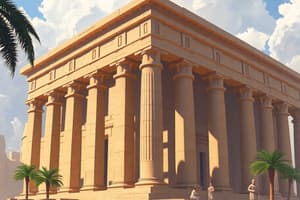Podcast
Questions and Answers
What was the main purpose of the Egyptian pyramids?
What was the main purpose of the Egyptian pyramids?
- Trade centers
- Religious ceremonies
- Observatories
- Tombs for the pharaohs (correct)
Who was responsible for the construction of the Great Pyramid at Gizeh?
Who was responsible for the construction of the Great Pyramid at Gizeh?
- Cheops (correct)
- Mnesicles
- Hermes
- Rameses II
Which structure serves as the grand entrance to the Acropolis?
Which structure serves as the grand entrance to the Acropolis?
- The Parthenon
- The Propylaea (correct)
- The Colosseum
- The Temple of Zeus
Which architectural feature allowed Romans to create large interior spaces?
Which architectural feature allowed Romans to create large interior spaces?
What is the primary characteristic of Byzantine architecture from the 5th century onwards?
What is the primary characteristic of Byzantine architecture from the 5th century onwards?
Which order of architecture was introduced by the Romans?
Which order of architecture was introduced by the Romans?
What material is primarily used for facing walls that distinguishes Romanesque architecture in Italy?
What material is primarily used for facing walls that distinguishes Romanesque architecture in Italy?
Which building is regarded as the most nearly perfect example of Greek architecture?
Which building is regarded as the most nearly perfect example of Greek architecture?
What mineral was crucial for Greek architecture, especially for creating sculptures?
What mineral was crucial for Greek architecture, especially for creating sculptures?
What was the primary purpose of amphitheaters in ancient times?
What was the primary purpose of amphitheaters in ancient times?
Which of the following defines the term 'Acropolis' in ancient Greek cities?
Which of the following defines the term 'Acropolis' in ancient Greek cities?
What is the name of the dining hall in a monastery or college?
What is the name of the dining hall in a monastery or college?
Which term describes the characteristic ornamentation of ancient Greek architecture?
Which term describes the characteristic ornamentation of ancient Greek architecture?
What architectural style is known for its curved lines?
What architectural style is known for its curved lines?
What is the term for the space between the colonnade and the naos wall in a Greek temple?
What is the term for the space between the colonnade and the naos wall in a Greek temple?
Where is the outstanding group of Romanesque architecture primarily found?
Where is the outstanding group of Romanesque architecture primarily found?
What is the purpose of the Frigidarium in the Thermae?
What is the purpose of the Frigidarium in the Thermae?
Which room in the Thermae is specifically for oils and unguents?
Which room in the Thermae is specifically for oils and unguents?
Which direction do Greek temples typically face?
Which direction do Greek temples typically face?
What is the term for the raised area in some churches that developed into the transept?
What is the term for the raised area in some churches that developed into the transept?
What movement during the Byzantine period forbade the use of statues?
What movement during the Byzantine period forbade the use of statues?
Who were the architects of the Hagia Sophia?
Who were the architects of the Hagia Sophia?
What is the orientation of the Etruscan temple?
What is the orientation of the Etruscan temple?
What is a key feature of the Cancelli in a church?
What is a key feature of the Cancelli in a church?
What is a defining characteristic of a 'Nymphaeum' in classic architecture?
What is a defining characteristic of a 'Nymphaeum' in classic architecture?
Which architect is associated with the philosophy of 'form follows function'?
Which architect is associated with the philosophy of 'form follows function'?
Who conceptualized the Corinthian capital in architecture?
Who conceptualized the Corinthian capital in architecture?
In which civilization did the atrium type house first originate?
In which civilization did the atrium type house first originate?
What feature typically defines 'Insulae' in Roman urban settlements?
What feature typically defines 'Insulae' in Roman urban settlements?
What is the function of an architrave in classical architecture?
What is the function of an architrave in classical architecture?
What is a 'Thalamus' in the context of ancient architecture?
What is a 'Thalamus' in the context of ancient architecture?
Which structure is known for being initiated by Thothmes I?
Which structure is known for being initiated by Thothmes I?
What is the usual number of stories for a Chinese pagoda?
What is the usual number of stories for a Chinese pagoda?
What are 'Rock-Hewn Tombs' primarily built for?
What are 'Rock-Hewn Tombs' primarily built for?
Which of the following structures is famous for its large dome?
Which of the following structures is famous for its large dome?
What architectural feature is described as a triangular piece of wall above the entablature?
What architectural feature is described as a triangular piece of wall above the entablature?
Which term refers to the central part of a church, usually flanked by aisles?
Which term refers to the central part of a church, usually flanked by aisles?
What is the plan shape of a Japanese pagoda?
What is the plan shape of a Japanese pagoda?
What is the purpose of a tokonama in Japanese houses?
What is the purpose of a tokonama in Japanese houses?
What is a pendentive in architecture?
What is a pendentive in architecture?
Flashcards are hidden until you start studying
Study Notes
Egyptian Architecture
- Tombs of pharaohs, the focal point of ancient Egyptian architectural practice, are represented by pyramids.
- The Great Pyramid at Gizeh, built during the 4th Dynasty, was commissioned by Pharaoh Cheops.
- Rameses I initiated the construction of the Great Hypostyle Hall at Karnak and founded the 19th dynasty.
Greek Architecture
- Marble is the primary mineral utilized in Greek architecture, with Greece having ample supply.
- Greek architecture is characterized by a columnar trabeated system.
- The Propylaea serves as the grand entrance to the Acropolis, designed by architect Mnesicles.
- The Parthenon is regarded as the most nearly perfect structure erected in the Acropolis.
Roman Architecture
- Romans revolutionized architecture with concrete, particularly using pozzolan to create arches and vaults for expansive interiors.
- The Composite order, a hybrid of previous architectural styles, was introduced by the Romans.
- Known for its sober and dignified aesthetic, Romanesque architecture features marble-faced walls, especially in Italy.
- The Pantheon stands as the ultimate example of preservation for ancient Roman buildings.
Byzantine Architecture
- Dominated by domical roof construction, Byzantine architecture has remained influential since the 5th century.
- Hagia Sophia in Constantinople is the finest surviving example of Byzantine architecture, noted for its large dome.
- The architectural plan of Byzantine churches is typically centralized.
Classical Architecture Elements
- The architecture of the classical style includes key features like the pediment, a triangular section above the entablature.
- A pendentive aids in transitioning between a dome and its supporting structure.
- Elements of entablature include the architrave, frieze, and cornice, arranged from top to bottom.
Romanesque Architecture
- Italian Romanesque architecture is distinctively marked by marble use for wall facings.
- Pisa is home to the most outstanding examples of Romanesque architecture.
- A typical Roman structure such as insulae served for urban living, akin to apartment blocks.
Notable Architectural Features
- The narthex serves as a long arcaded entrance in early Christian churches.
- The nave is the central part of a church, usually flanked by aisles.
- An ambulatory is the covered walk surrounding an atrium, often seen in basilicas.
Ornamentation and Decoration
- Classic ornaments like anthemion reflect traditional Greek designs.
- The fret consists of intersecting straight lines, used in classical and Renaissance architecture.
- The acroterion, a pedestal on roofs, often supports decorative elements.
Important Figures and Concepts
- Callimachus is noted for conceptualizing the Corinthian capital.
- Buckminster Fuller innovated the Dymaxion House, termed the "first machine for living."
- Louis Sullivan is famous for the phrase "Form follows function," emphasizing functional design.
Cultural Aspects
- The iconoclastic movement in Byzantine culture prohibited the usage of statues in religious contexts.
- The orientation of Roman temples faces the Forum, Greek temples towards the East, and Etruscan temples towards the South.
- Throughout history, architectural orientations have been significant for cultural and spiritual symbolism.
Additional Concepts
- The outstanding features of Japanese houses include the tokonama, a space for displaying art or flowers.
- The architectural design of a Chinese pagoda is typically octagonal, with a standard number of 13 stories.
- The terms Frigidarium, Calidarium, and Tepidarium refer to different thermal rooms in ancient Roman baths, showcasing the complex nature of Roman public baths.
Studying That Suits You
Use AI to generate personalized quizzes and flashcards to suit your learning preferences.




